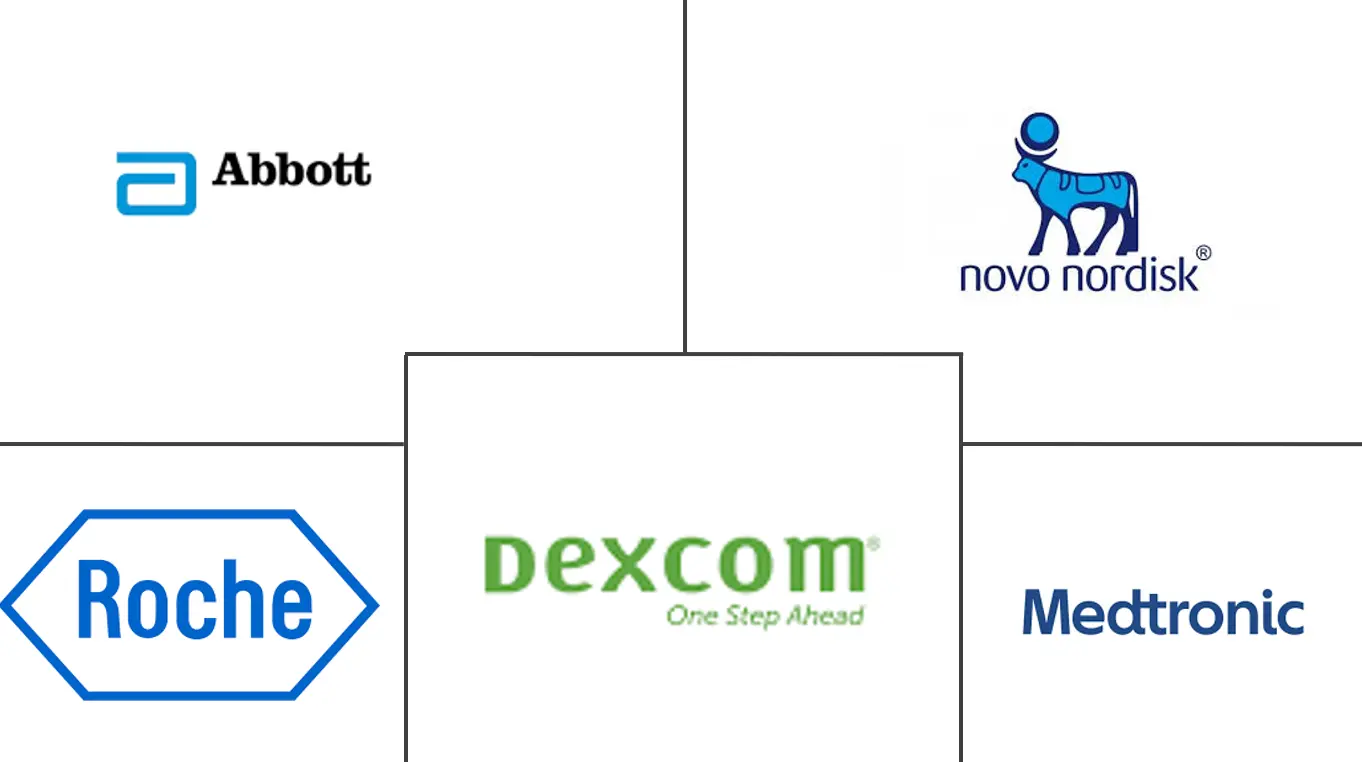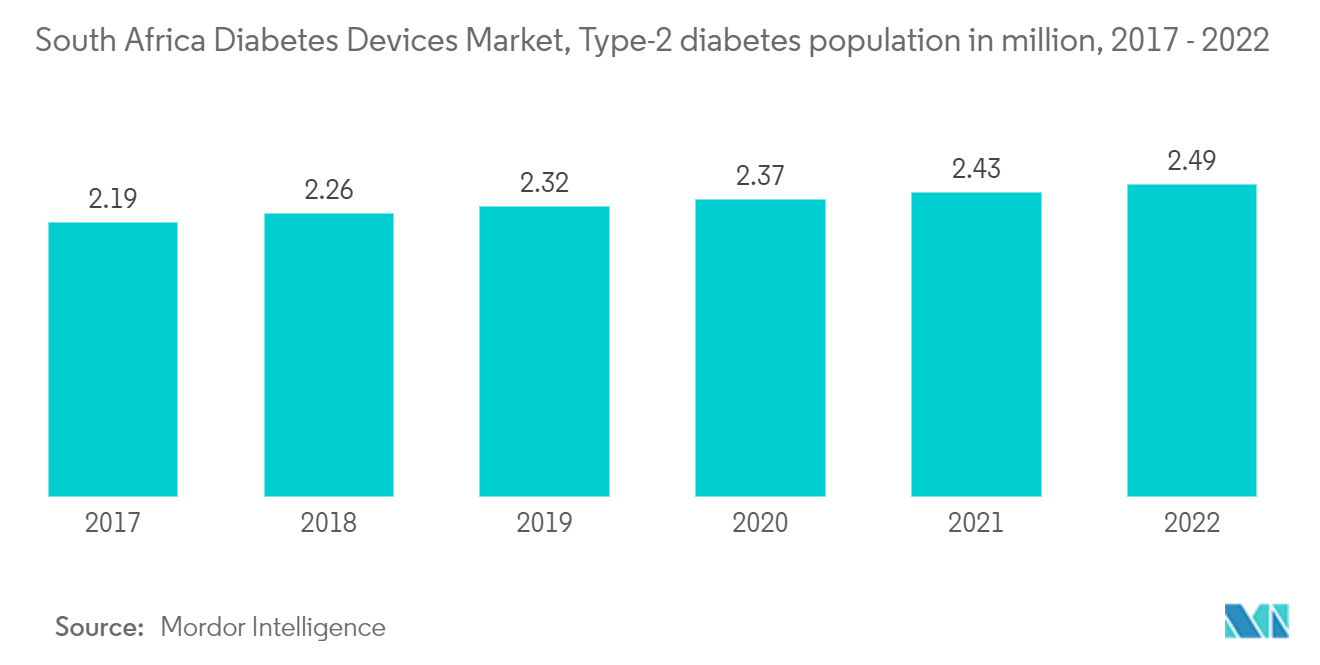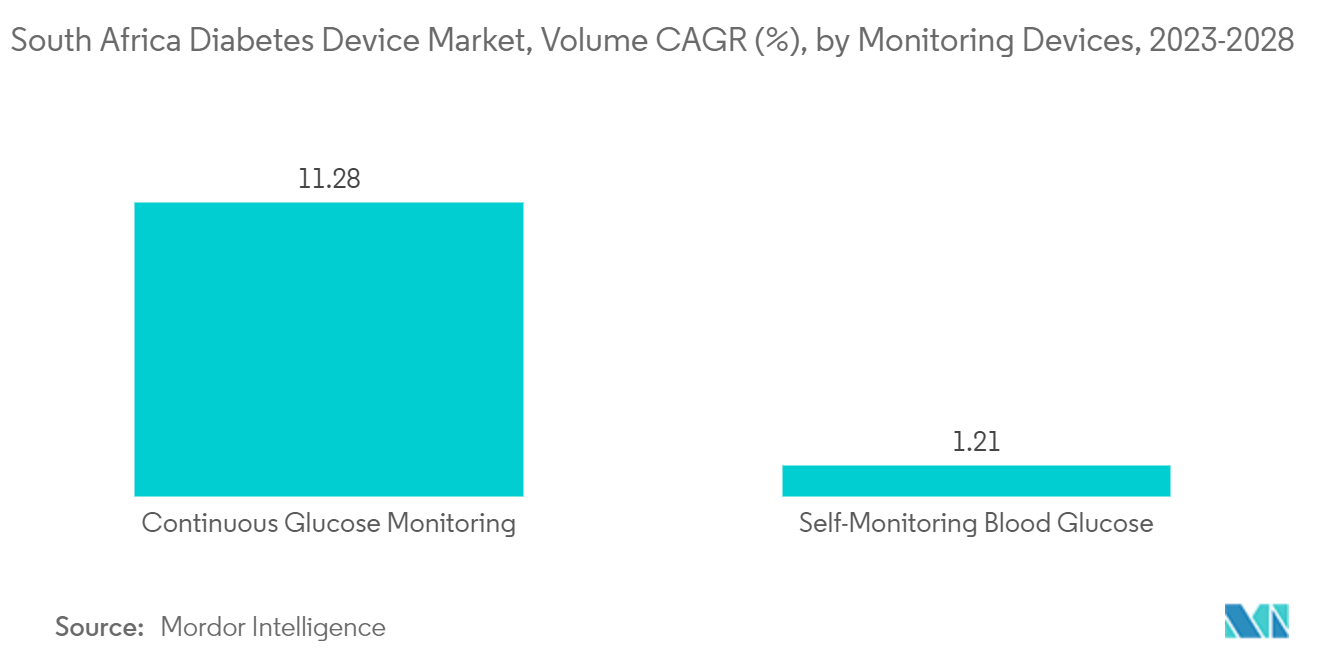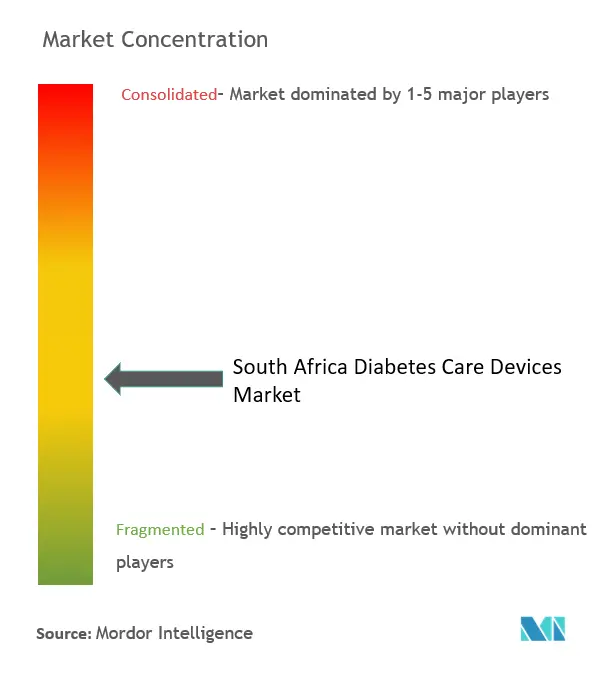South Africa Diabetes Care Devices Market Size

| Study Period | 2017- 2028 |
| Base Year For Estimation | 2022 |
| Forecast Data Period | 2023 - 2028 |
| Market Size (2023) | USD 146.56 Million |
| Market Size (2028) | USD 179 Million |
| CAGR (2023 - 2028) | 4.08 % |
Major Players
*Disclaimer: Major Players sorted in no particular order |
Need a report that reflects how COVID-19 has impacted this market and its growth?
South Africa Diabetes Care Devices Market Analysis
The South Africa Diabetes Care Devices Market size is estimated at USD 147 million in 2023, and is expected to reach USD 179 million by 2028, growing at a CAGR of 4.08% during the forecast period (2023-2028).
and is estimated to reach around USD 172 million by 2027.
The COVID-19 pandemic positively impacted the South Africa Diabetes Care Devices Market growth. Patients with diabetes, infected with COVID-19 may experience elevated blood glucose, abnormal glucose variability, and diabetic complications. In South Africa, as of July 2022, there have been 40,02,133 confirmed cases of COVID-19 with 101,943 deaths, reported to WHO. The prevalence of diabetes in people with COVID-19 caused a significant increase in severity and mortality of COVID-19 in people with either type 1 (T1DM) or type 2 diabetes mellitus (T2DM), especially in association with poor glycemic control. While new-onset hyperglycemia and new-onset diabetes (both T1DM and T2DM) have been increasingly recognized in the context of COVID-19 and have been associated with worse outcomes. To avoid aggravation, a patient's blood glucose should be monitored and maintained regularly, which has underlined the importance of diabetes care devices.
According to IDF Diabetes Atlas 2021, one in nine adults in South Africa are living with diabetes. The main diagnosis for diabetes patients is imbalances in blood glucose levels, which are not in compliance with the standard blood glucose levels. The general lab diagnostic tests can only help to diagnose the disease by physicians. Patients with more fluctuations in glucose levels need to get it checked every day. Patients administering insulin need to check their blood glucose levels frequently, adjust the doses of insulin, or change the medication, if necessary.
The rate of newly diagnosed Type 1 and Type 2 diabetes cases is seen to increase, mainly due to obesity, unhealthy diet, and physical inactivity. The rapidly increasing incidence and prevalence of diabetic patients and healthcare expenditure in developed countries are indications of the increasing usage of diabetic care products. Moreover, the increasing adoption of insulin delivery devices and the rising prevalence of diabetes are driving the market growth. Leading manufacturers are focusing on technological innovations and the development of advanced products to gain a substantial share of the market.
Therefore, owing to the aforementioned factors the studied market is anticipated to witness growth over the analysis period.
South Africa Diabetes Care Devices Market Trends
Increasing Diabetes Prevalence
The diabetes population in South Africa is expected to rise by about 2.5% over the forecast period.
The diabetes prevalence in South Africa reached 11.3%, the highest in Africa. The cost of diabetes-related health expenditure rose to 1,700 USD per person, estimated to be around 7.2 billion USD, according to IDF 2021.
Rapid urbanization, characterized by adopting unhealthy energy-dense diets and physical inactivity, contributed to the steadily increasing obesity epidemic. It is majorly with women in South Africa being overweight or obese. Obesity is a major contributor to the T2DM epidemic, with excess body weight estimated to account for 87% of T2DM cases in South Africa. In addition, these studies report high rates of newly diagnosed diabetes and glucose intolerance, which are associated with a higher annual risk of developing T2DM.
One of the main aims of diabetes treatment is to keep blood glucose levels within a specified target range which can be achieved by balancing food with activity, lifestyle, and diabetes medicines. Blood glucose monitoring readings provide the information required to determine the best management strategy for diabetes. The number of times people with diabetes who use insulin will check their blood glucose levels varies according to several factors. People with type 2 diabetes not using insulin may not need to check their blood glucose levels as regularly. However, they can find structured self-monitoring to be helpful.
One of the most effective ways to decrease the prevalence of diabetes in South Africa is to educate citizens and encourage healthy decision-making. South Africa is currently working towards this goal. One recent preventative measure the South African government took was implementing a sugar tax. By charging more for sugary drinks and foods, the government is fighting obesity and helping citizens make more conscious decisions. South Africa briefly launched a Diabetes Prevention Programme (DPP). The DPP aims to integrate intervention treatments into a culturally relevant context through household questionnaires and group gatherings for at-risk individuals.
Therefore, the studied market is anticipated to grow over the analysis period due to rising prevalence and the factors above.

The Continuous Glucose Monitoring Segment is expected to dominate the South African Diabetes Care Devices Market over the forecast period
The continuous glucose monitoring segment is expected to witness a CAGR of more than 11.4% over the forecast period.
Continuous Glucose Monitoring Devices are automated glucose monitoring systems that consist of a small device that can be worn on the body and held on by an adhesive patch. The sensor part of the device includes a cannula inserted into the top layer of skin and uses interstitial fluid samples to check glucose levels. Sensors are connected to a transmitter that can send data wirelessly to a dedicated mobile receiving device or smartphone. Using CGMs for people with diabetes and their caregivers and communities is beneficial for managing their blood glucose and insulin levels to maintain their health outcomes. CGM makes it significantly easier to manage blood glucose levels by decreasing interruptions and allowing for better sleep. It also improves the mental health of patients or caregivers by reducing the overall mental load of managing diabetes, thereby enhancing the market prospects in the coming years.
Diabetes South Africa (DSA), the Society for Endocrinology, Metabolism, and Diabetes of South Africa (SEMDSA), and Youth with Diabetes are the various organizations in South Africa working towards helping diabetes patients. DSA is a nonprofit that centers around mobilizing volunteers to demand better treatment for those with diabetes and focuses on educating citizens and lobbying the government for better facilities and cheaper healthcare. Further, SEMDSA researches the genetic sources and causes of diabetes. This organization also promotes high treatment standards and encourages the widespread availability of medicine. The organizations are promoting the allocation of an increased budget dedicated to funding all aspects of diabetes care and providing a system for better coordination with the Council of Medical Schemes, the organization in charge of reimbursement, to limit out-of-pocket payments and prevent increased expenditure for patients.
Furthermore, the current continuous glucose monitoring devices can either display the trends in blood glucose levels by downloading the data or give a real-time picture of glucose levels through receiver displays. Continuous glucose monitoring devices are becoming cheaper with the advent of new technologies, like cell phone integration, which is likely to drive the segment.

South Africa Diabetes Care Devices Industry Overview
The South Africa Diabetes Care Devices Market is moderately fragmented with major players, such as Novo Nordisk, Dexcom, Medtronic, and other generic players.
South Africa Diabetes Care Devices Market Leaders
Dexcom Inc.
Abbott Diabetes Care
Novo Nordisk A/S
Roche Diabetes Care
Medtronic PLC
*Disclaimer: Major Players sorted in no particular order

South Africa Diabetes Care Devices Market News
- September 2022: Abbott announced new data from the Real-World Evidence of the FreeStyle Libre study showing that using FreeStyle Libre, a continuous glucose monitoring system, significantly reduced the rate of hospitalizations. It is due to acute diabetes events for people with Type 2 diabetes on once-daily (basal) insulin therapy.
- June 2022: LifeScan announced that the peer-reviewed journal Diabetes Technology and Therapeutics published real-world evidence of improved glycemic control in people with diabetes. It uses a Bluetooth-connected blood glucose meter with Mobile Diabetes Management Application and the OneTouch Reveal mobile app with the OneTouch Verio Reflect meter- synced via Bluetooth wireless technology. It could support improved glycemic control for people with diabetes.
South Africa Diabetes Care Devices Market Report - Table of Contents
1. INTRODUCTION
1.1 Study Assumptions and Market Definition
1.2 Scope of the Study
2. RESEARCH METHODOLOGY
3. EXECUTIVE SUMMARY
4. MARKET DYNAMICS
4.1 Market Overview
4.2 Market Drivers
4.3 Market Restraints
4.4 Porter's Five Forces Analysis
4.4.1 Bargaining Power of Suppliers
4.4.2 Bargaining Power of Consumers
4.4.3 Threat of New Entrants
4.4.4 Threat of Substitute Products and Services
4.4.5 Intensity of Competitive Rivalry
5. MARKET SEGMENTATION
5.1 Management Devices
5.1.1 Insulin Pump
5.1.1.1 Insulin Pump Device
5.1.1.2 Insulin Pump Reservoir
5.1.1.3 Infusion Set
5.1.2 Insulin Syringes
5.1.3 Cartridges in Reusable Pens
5.1.4 Insulin Disposable Pens
5.1.5 Jet Injectors
5.2 Monitoring Devices
5.2.1 Self-monitoring Blood Glucose
5.2.1.1 Glucometer Devices
5.2.1.2 Blood Glucose Test Strips
5.2.1.3 Lancets
5.2.2 Continuous Glucose Monitoring
5.2.2.1 Sensors
5.2.2.2 Durables (Receivers and Transmitters)
6. MARKET INDICATORS
6.1 Type 1 Diabetes Population
6.2 Type 2 Diabetes Population
7. COMPETITIVE LANDSCAPE
7.1 Company Profiles
7.1.1 Becton and Dickinson
7.1.2 Medtronic
7.1.3 Insulet Corporation
7.1.4 Tandem Diabetes Care
7.1.5 Ypsomed AG
7.1.6 Novo Nordisk A/S
7.1.7 Sanofi
7.1.8 Eli Lilly
7.1.9 Abbott
7.1.10 F. Hoffmann-La Roche AG
7.1.11 Lifescan (Johnson & Johnson)
7.1.12 Dexcom
- *List Not Exhaustive
7.2 Company Share Analysis
7.2.1 Self-monitoring Blood Glucose Devices
7.2.1.1 Abbott
7.2.1.2 LifeScan
7.2.1.3 Others
7.2.2 Continuous Glucose Monitoring Devices
7.2.2.1 Dexcom
7.2.2.2 Medtronic
7.2.2.3 Others
7.2.3 Insulin Devices
7.2.3.1 Insulet Corporation
7.2.3.2 Novo Nordisk A/S
7.2.3.3 Others
8. MARKET OPPORTUNITIES AND FUTURE TRENDS
South Africa Diabetes Care Devices Industry Segmentation
Diabetes care devices are the hardware, equipment, and software used by diabetes patients to regulate blood glucose levels, prevent diabetes complications, lessen the burden of diabetes, and enhance the quality of life. The South Africa Diabetes Care Devices Market is segmented into management devices (insulin pumps (insulin pump devices, insulin pump reservoir, and infusion set), insulin syringes, insulin cartridges in reusable pens, disposable insulin pens, and jet injectors) and monitoring devices (self-monitoring blood glucose (glucometer devices, blood glucose test strips, and lancets) and continuous glucose monitoring (sensors and durables (receivers and transmitters)). The report offers the value (in USD million) and volume (in units million) for the above segments.
| Management Devices | |||||
| |||||
| Insulin Syringes | |||||
| Cartridges in Reusable Pens | |||||
| Insulin Disposable Pens | |||||
| Jet Injectors |
| Monitoring Devices | |||||
| |||||
|
South Africa Diabetes Care Devices Market Research FAQs
How big is the South Africa Diabetes Care Devices Market?
The South Africa Diabetes Care Devices Market size is expected to reach USD 146.56 million in 2023 and grow at a CAGR of 4.08% to reach USD 179 million by 2028.
What is the current South Africa Diabetes Care Devices Market size?
In 2023, the South Africa Diabetes Care Devices Market size is expected to reach USD 146.56 million.
Who are the key players in South Africa Diabetes Care Devices Market?
Dexcom Inc., Abbott Diabetes Care, Novo Nordisk A/S, Roche Diabetes Care and Medtronic PLC are the major companies operating in the South Africa Diabetes Care Devices Market.
South Africa Diabetes Care Devices Industry Report
Statistics for the 2023 South Africa Diabetes Care Devices market share, size and revenue growth rate, created by Mordor Intelligence™ Industry Reports. South Africa Diabetes Care Devices analysis includes a market forecast outlook to for 2023 to 2028) and historical overview. Get a sample of this industry analysis as a free report PDF download.
